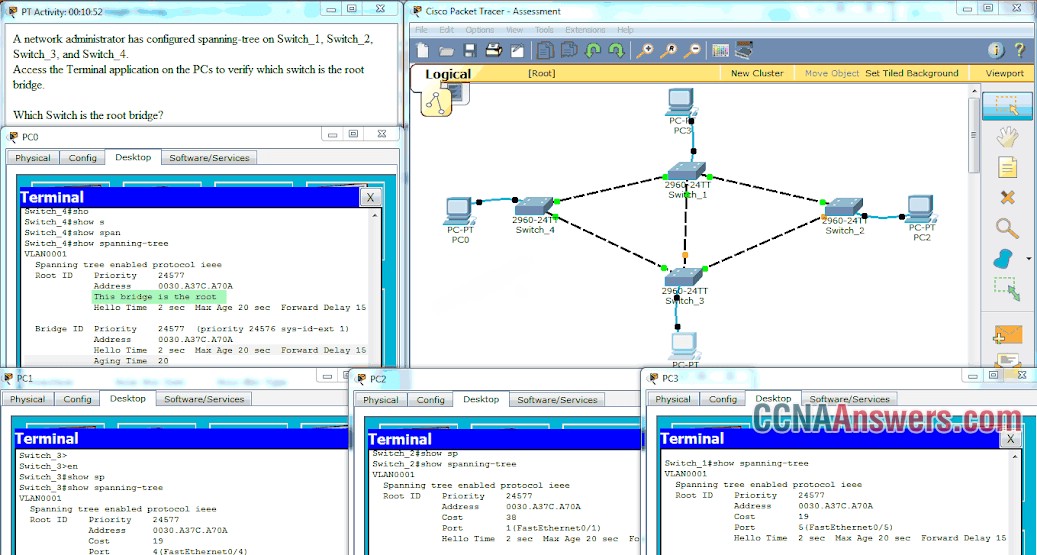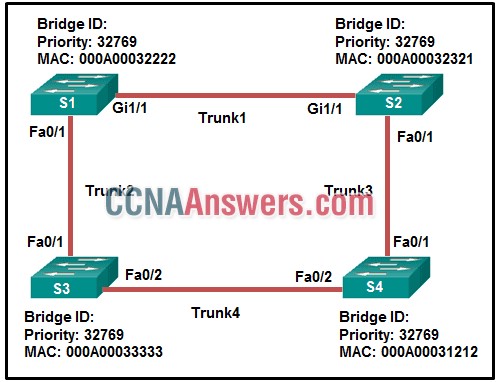CCNA 3 Chapter 3 V6.0 Answers
1. A network administrator is preparing the implementation of Rapid PVST+ on a production network. How are the Rapid PVST+ link types determined on the switch interfaces?
Link types can only be determined if PortFast has been configured.
Link types are determined automatically.
Link types can only be configured on access ports configured with a single VLAN.
Link types must be configured with specific port configuration commands.
2. Which spanning tree standard supports only one root bridge so that traffic from all VLANs flows over the same path?
802.1D
PVST+
MST
Rapid PVST
3. What is the outcome of a Layer 2 broadcast storm?
ARP broadcast requests are returned to the transmitting host.
Routers will take over the forwarding of frames as switches become congested.
CSMA/CD will cause each host to continue transmitting frames.
New traffic is discarded by the switch because it is unable to be processed.
4. Which protocol provides up to 16 instances of RSTP, combines many VLANs with the same physical and logical topology into a common RSTP instance, and provides support for PortFast, BPDU guard, BPDU filter, root guard, and loop guard?
MST
PVST+
STP
Rapid PVST+
5. Refer to the exhibit. Which switch will be elected the root bridge and which switch will place a port in blocking mode? (Choose two.)

SW2 will become the root bridge.
SW4 will get a port blocked.
SW3 will become the root bridge.
SW1 will become the root bridge.
SW4 will become the root bridge.
SW2 will get a port blocked.
6. Which three components are combined to form a bridge ID?
MAC address
cost
port ID
IP address
extended system ID
bridge priority
7. Refer to the exhibit. What is the role of the SW3 switch?

local bridge
edge switch
designated switch
root bridge
enabled bridge
8. Open the PT Activity. Perform the tasks in the activity instructions and then answer the question.
Which switch is the root bridge?

Switch_4
Switch_1
Switch_3
Switch_2
9. If no bridge priority is configured in PVST, which criteria is considered when electing the root bridge?
highest MAC address
lowest MAC address
highest IP address
lowest IP address
10. What is a characteristic of a Layer 2 loop?
Routers continually forward packets to other routers.
The Time-to-Live attribute of a frame is set to infinity.
A switch is continually forwarding the same unicast frame.
Broadcast frames are forwarded back to the sending switch.
11. Which two types of spanning tree protocols can cause suboptimal traffic flows because they assume only one spanning-tree instance for the entire bridged network? (Choose two.)
PVST+
MSTP
Rapid PVST+
RSTP
STP
12. What port type is used to interconnect switches in a switch stack?
Root
designated
edge
StackWise
13. Fill in the blank. Do not use abbreviations.
The spanning-tree mode rapid-pvst global configuration command is used to enable Rapid
14. Which port state will switch ports immediately transition to when configured for PortFast?
Learning
blocking
listening
forwarding
15. What additional information is contained in the 12-bit extended system ID of a BPDU?
VLAN ID
MAC address
IP address
port ID
16. Which RSTP ports are connected to end devices?
trunk ports
edge ports
designated ports
root ports
17. Which two network design features require Spanning Tree Protocol (STP) to ensure correct network operation? (Choose two.)
static default routes
redundant links between Layer 2 switches
implementing VLANs to contain broadcasts
link-state dynamic routing that provides redundant routes
removing single points of failure with multiple Layer 2 switches
18. Which Cisco switch feature ensures that configured switch edge ports do not cause Layer 2 loops if a port is mistakenly connected to another switch?
PVST+
BPDU guard
PortFast
extended system ID
19. Which STP priority configuration would ensure that a switch would always be the root switch?
Spanning-tree vlan 10 priority 61440
spanning-tree vlan 10 root primary
spanning-tree vlan 10 priority 4096
spanning-tree vlan 10 priority 0
20. To obtain an overview of the spanning tree status of a switched network, a network engineer issues the show spanning-tree command on a switch. Which two items of information will this command display? (Choose two.)
The number of broadcasts received on each root port.
The root bridge BID.
The role of the ports in all VLANs.
The status of native VLAN ports.
The IP address of the management VLAN interface.
21. Refer to the exhibit. Which trunk link will not forward any traffic after the root bridge election process is complete?

Trunk2
Trunk1
Trunk4
Trunk3
22. What is the purpose of the Spanning Tree Protocol (STP)?
Creates smaller collision domains
creates smaller broadcast domains
allows Cisco devices to exchange routing table updates
prevents routing loops on a router
prevents Layer 2 loops
23. What is an advantage of PVST+?
PVST+ optimizes performance on the network through autoselection of the root bridge.
PVST+ reduces bandwidth consumption compared to traditional implementations of STP that use CST.
PVST+ requires fewer CPU cycles for all the switches in the network.
PVST+ optimizes performance on the network through load sharing.
24. Match the spanning-tree feature with the protocol type. (Not all options are used.)

PVST+ = Cisco implementation of IEEE 802.1D
RSTP = Fast converging enhancement of IEEE 802.1D
MSTP = IEEE standard that reduces the number of STP instances
Rapid PVST+ = Proprietary per VLAN implementation of IEEE 802.1w
25. In which two port states does a switch learn MAC addresses and process BPDUs in a PVST network? (Choose two.)
learning
blocking
disabled
forwarding
listening


Leave a Reply